joxin-lookingoutwards01
“RMB City” (2008–2011) by Cao Fei and team

links: Cao Fei’s website | project site | project vimeo
“RMB City” (2008–2011) is a virtual urban landscape created by mainland Chinese artist Cao Fei and her team on Second Life, a platform for 3D virtual world. It is a collage of digital objects that signify many characteristics of urban living in modern Chinese cities.
Cao Fei and her team selected images that contain cultural and socio-political symbols in various Chinese cities, and sent them to the builders of Second Life overseas to create this 3D landscape. In a way, they were curators and architects. They took advantage of the technologies and platforms provided by Second Life, as well as skilled people abroad. Both process and product of this cross-cultural workflow revealed differences and similarities between Eastern and Western aesthetics and symbolisms.
Can Fei called this project a “dramatic mimicry” of Chinese urban environment. Over the winter break, I went to see an art exhibit called “Discordant Harmony” in Beijing about Eastern Asian art practice between the 1980s and 1990s. Those decades were immediately after the Chinese economic reform, which introduced Western ideas and technologies to the population after ten years of intellectual stagnation during the Cultural Revolution. There were critical dialogues in the art realm about how to balance between tradition and westernization, as well as urban youth culture. Cao Fei grew in this era, graduating college in 1997. She was among the generation of young Chinese artists who experimented with new media and new subjects and examined their own identities. I think RMB City is a product of this ideological trend. Mimicking the Chinese urban world with the support of new technology abroad, RMB City criticizes and reflects on a society with rapid changes and clashing forces.
Since the 1990s, the political climate in mainland China has shifted immensely. Art (specially “first word art” in Michael Naimark’s words) has very much shied away from public discourse. Cao Fei’s recent projects have been for clients like BMW and Louis Vuitton. However, I still feel extremely hopeful knowing a project like RMB City existed. I admire its sophistication and humor. I also think it shows the power of non-verbal political commentary in the virtual space, the power of “dramatic mimicry,” which I think is a valuable strategy for a society like China.
The aesthetics of RMB City speaks to me in two different ways.(These are just what I think. I can’t say if the artist intended for these effects.) On one hand, the low-fi look insinuates the fragile, artificial, and mythical societal structure of modern-day China, which is essentially a blood-soaked anthill pretending to be a global power. On the other hand, the vibrance and richness of the city remind me of the uncontainable strength and unlimited possibilities in the life of the people.